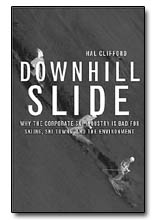|
written by Allen Best

From today’s perspective, the golden
age of skiing and ski towns occurred in the 1960s, 1970s
and even the early 1980s. Ski areas grew robustly, cashing
in on outdoor athleticism and pristine mountain intimacy.
But by the mid-1980s, ski towns were sprawling into lifestyle
valleys. Real estate edged ahead of skiing as the dominant
economic driver. Chalets were razed to make way for mansions.
Immigrant laborers arrived to toil. The gap between rich
and poor widened. And ski areas resorted to robbing one
another of skiers. There was growth but not particularly
on the slopes.
Finally, late in the 1990s, Wall Street got involved.
The industry consolidated, led by three new publicly traded
companies. These companies brought new skill to the sport
of making money, with slopeside real estate being the
easiest. Meanwhile, down along the highways, franchises
started crowding the highways with big box stores, burger
joints and designer coffees.
In Downhill Slide, Hal Clifford dives into these changes
and finds a bad guy, as identified in the book’s
subtitle: “Why the Corporate Ski Industry is Bad
for Skiing, Ski Towns and the Environment.”
Skiing, he says, has been transformed into a “come-hither
amenity” to sell real estate. Agents of this change,
he says, are the “Big Three” – Vail
Resorts, Intrawest and the American Skiing Co. In Colorado,
Vail Resorts has Vail, Beaver Creek, Breckenridge and
Keystone; Intrawest has Copper Mountain, operates Winter
Park and is building projects at Snowmass and Keystone.
The American Skiing Co. has Steamboat.
Clifford argues that ski resorts are losing what made
them special in the first place, thus becoming “more
like the rest of America.” Is this, he asks, the
ordering of the world for ski towns?
Regardless of whether you accept this question or its
premise, Clifford has done an often-wonderful job of analyzing
ski industry economics and history. He argues that skiing
started down the wrong road with Vail, which opened in
1962 and made skiing essentially an amenity to real estate.
That idea, copied later at Snowmass, has since become
the model for ski area development, he says.
Downhill Slide is well written and at times fascinating,
such as when it explains how Intrawest has taken the “village”
concept to a new level. Even the chocolatier at Copper
Mountain works in a window positioned to be seen by pedestrians
as they round the corner. Nothing is left to doubt. Disney,
long feared in mountain towns, seems to have arrived wearing
the name of Intrawest.
Clifford also charges that the U.S. Forest Service, which
manages most lands used for downhill skiing in the West,
often kowtows to the industry and reneges on its responsibilities
as an environmental watchdog. His alternative? Have ski
communities buy ski-area operations, if necessary condemning
them, as was considered in Vail a decade ago. He envisions
ski towns as places where artisans, writers and other
lone-eagle entrepreneurs can do business, fashioning the
ski hill as an amenity or economic force as they see fit.
Locals will gain control, he says, instead of being controlled.
In wagging his finger at corporate ski companies, Clifford
gives them more blame than deserved. The boom in mountain
living is larger than publicly held ski companies or,
for that matter, the ski industry. Skiing has to do with
second-homes and urbanization. Perhaps an even more telling
analysis would be of how transportation shapes the flow
of money in the West. He acknowledges that link but does
not dwell on it.
At times, Clifford comes up short. He blames Vail Resorts,
for example, for fatalities on Highway 24 between Leadville
and I-70. More careful research would have revealed that
virtually none of the fatalities were commuting workers.
At other times, as when he accuses Vail Resorts of having
too much power, his research doesn’t support his
argument. He doesn’t produce a smoking gun so much
as just smoke. Although I happen to agree that Vail Resorts
has a potentially unhealthy influence on Colorado and
other places, I’ve seen nothing but speculation
about improper influence.
Finally, although Clifford denies indulging in nostalgia,
I think he veers in that direction to no good end. I detect
favoritism for the old towns where miners and ranchers
did the dirty work of real estate development. This is
a little bit like old money looking down its nose at new
money.
Nevertheless, Downhill Slide connects in many ways –
both intellectual and emotional. There is a general sense
in ski towns that our valleys have become too driven by
material things. And that’s his point – that
the ski valleys have become places of excess, whether
it’s too many gimmicks on the slopes, too many burger
joints along the highway or too many mansions that sit
empty. When the mountains are almost incidental to ski
town living, as they seem to be in many cases, we’re
all the poorer for it. n
If you can pardon his excesses in making that point,
this is a good start to a long-overdue discussion about
how the West wants to develop. To the extent that Downhill
Slide helps us look to that future – and not nostalgically
at some foggy notion of our youth – it’s a
valuable book.
|

